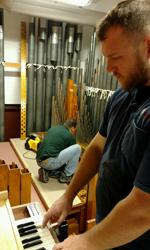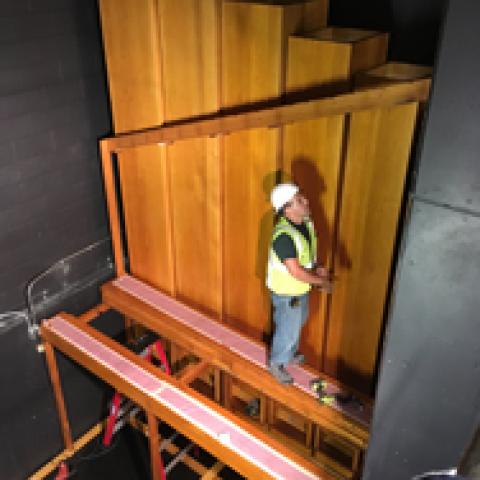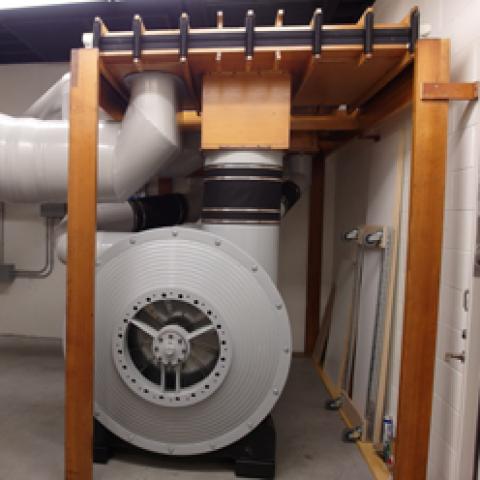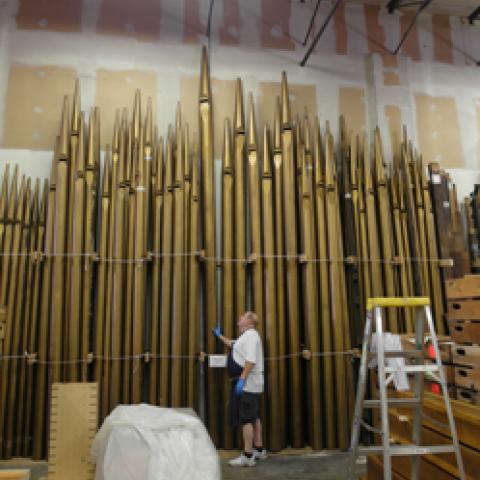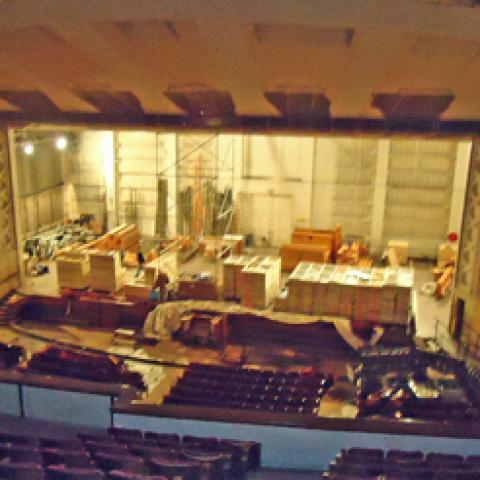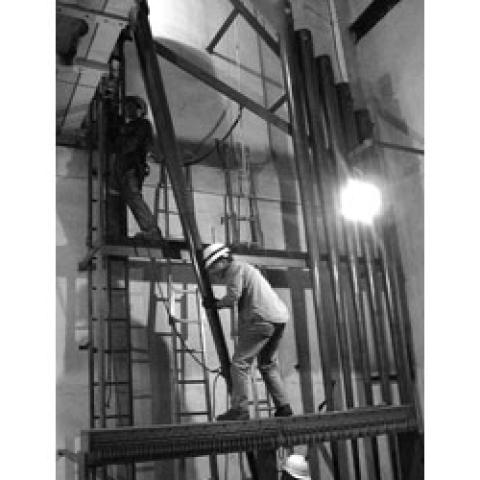Foley-Baker, Inc.,
Tolland, Connecticut
St. Mark’s Episcopal Cathedral,
Minneapolis, Minnesota
From the builder
The Welte name is mostly known for its roll-player mechanisms, the Mignon reproducing piano, and their Orchestrion. However, as builders of traditional pipe organs, Welte’s output was small; organs were but one in a family of Welte “products” typical of the era’s massive instrumental output. In 1912, Welte opened a factory in Poughkeepsie, New York, but their earliest organs were purchased from other builders and fitted with Welte players. Since Welte was of German ownership, the First World War threw things into disarray, and after the war, ownership changed hands. A larger reorganization in 1925 by former Kimball man Robert Pier Elliot had Welte building its own organs of fine quality and for any venue: residence, theater, or church. But the firm struggled to gain a strong financial footing. It suffered a setback in 1927, repurchase and relocation in 1929, and finally absorption by Kimball of Chicago in 1931. Today, there are few surviving examples of Welte organs, and, even after our 42 years in business, we had never worked on one. St. Mark’s Minneapolis would be a new experience.
The cathedral’s consultant was David Engen of Maple Grove, Minnesota. His request for proposal offered a general description of the organ’s overall condition. Our assumption was that we would see huge diapasons, pencil-scale strings, and tibia-like flutes, all on a massive chassis. In fact, the St. Mark’s Welte had been tonally and mechanically modified on two different occasions by M.P. Möller. Much of the Welte material was long gone, although the organ remained capable of producing an impressive volume of sound.
But it was clear the various rebuilds had compromised the instrument. The chamber was packed with non-Welte chests, flexible wind lines, dangling wires, and a chamber entrance door that barely opened, due to added ranks and equipment. There were reservoirs everywhere, fully 17 in the main organ. Tuning access was bad enough, while actual service work required unnecessarily heroic effort. One reason the organ continued to generate an impressive sound was the chamber’s placement and hard walls. More than projecting sound, the chamber almost seemed to amplify it. The cathedral’s impressive acoustics certainly helped as well.
The organ was on its third console and had a dated relay system spread throughout four different areas of the building. In the basement, the large Spencer blower’s motor needed all new bearings. Adding insult to injury, HVAC ducts installed in the 1950s had seen the removal of the organ’s important static reservoirs, further compromising the wind supply.
At Foley-Baker, we love to save old organs. However, it was clear that at St. Mark’s, there wasn’t an old organ to save, just parts of one. Trying to determine what was possible and affordable would take both positive and practical thinking. If the organ were to be rebuilt, the results had to be worth the investment.
We spent days measuring pipe scales and gathering details. There were interesting finds, such as high in the tower, where the Möller crew had stored some of the 1928 Welte pipework. There was much damage; some ranks were incomplete, while others were beyond repair. Our tonal director Milovan Popovic laid out rank after twisted rank on the large tower room floor. Out of this survey we found three Welte stops to reclaim: the Swell 4′ Clarion, Great 8′ Second Open Diapason, and the large-scale Swell 8′ Vox Humana. All three became valuable additions.
As our familiarity with the cathedral’s music program and organ grew, so did our concepts for the renewed instrument. Tonally, we had 1920s Welte mixed with 1980s Möller. In 2012 it is perhaps too easy to criticize Möller’s radical changes as heavy-handed; they were in the spirit of the time, and had introduced a variety of useful colors, including mutations, large-scale strings, and solo reeds. In time, we decided just where and what reused ranks would work and what new ones had to be added to create a bold, cohesive American sound to fill the cathedral’s large nave.
The chamber size and shape dictated the same stacked layout as had existed from the beginning. For us, multi-level organs raise red flags for service accessibility. Without careful design, the new and larger instrument had the potential for being another service nightmare. Our solution was to start from scratch, using a new chassis designed and built at Organ Supply Industries. The elegant simplicity of their slider chests promised minimal maintenance and assurance of accessibility. Their built-in schwimmer-regulators greatly simplified the winding, adding space for more stops and wider passage boards.
Given the scales and pressures, effective swell boxes would be essential. The original Welte shades were rebuilt and fitted to new boxes of 11⁄2-inch-thick medium density fiberboard. The combination of the two makes for a marvelous range of expression; massive ensembles can whisper or roar.
In addition to restoring the 1928 Spencer blower, we were able to find and install appropriate static reservoirs. Unlike 1928, however, this equipment now stands in separate rooms dedicated for the purpose. The result is that, despite wind pressures from five to 20 inches, an indicator light is necessary to know that the wind is on. As we have done elsewhere, we designed and installed an automatic, in-chassis humidity system that requires minimal service attention and combats Minnesota’s problematic humidity swings.
The low-profile Schantz console dating from 1990 was reused, with modified stop jambs, new drawknobs, and burled mahogany jamb faces for a sharper appearance. (Schantz graciously provided and installed new, easy-to-read piston buttons.) We installed a new electronic relay that is easily accessed by simply raising the now-hinged console lid.
Years of change had seen many stops swapped between divisions. The Choir Diapason had been moved into the Solo as a 4′ Octave. We returned it to the Choir at 8′ with a new bass octave. The Welte Second Open found in the tower became our Great Diapason. Other stops were also returned to their original 1928 locations. The renewed instrument is a blend of remaining Welte pipework, selected Möller ranks, and important new registers. All retained ranks were cleaned, repaired, and revoiced, perhaps none more important than original large pedal basses and their Welte chests. These provided the weight and heft we envisioned as a foundation for the new instrument.
The reed stops presented their own challenge, with ranks by five different builders and, in some cases, using scales and pressures dictated by available—or unavailable—space. Working with Chris Broome of Broome & Co. LLC, we examined the potential of each rank for our new scheme. In the end, we designed and had built an all-new Great reed chorus. Having found the original 1928 Welte 4′ Clarion, we were able to use it to recreate Welte’s original Swell reed chorus; industrial strength pipes with a just-right massive sound. A small-scale yet piercingly loud Möller Trumpet, which had been taking up valuable room in a corner of the Great, was revoiced into an ideally scaled Choir Trompette. Chorus reeds now serve to cap wonderful choruses, enriched by solo stops such as the Skinner Clarinet or Kimball Corno d’amour.
The new organ’s sound ties together all the good qualities that go into creating it: the new specification, high pressures and large scales, the chamber’s ability to project sound and the swell shutters’ ability to contain it, and the new layout and chassis, which provided optimal placement for all stops. As the bottom photo on the front cover clearly displays, even 1928 pipes can look (and sound) like new. We were really thrilled to hear Canon Musician Ray Johnston play the “new” organ at the inaugural concert on May 18, an outstanding program that included brass and the cathedral’s choirs. To him and David Engen we owe thanks for supporting us in this challenging and rewarding project.
Upcoming concerts involving the rebuilt organ are posted on the cathedral’s website. All photos of the cathedral and reconditioned instrument are by Mark Manring (www.manring.net). All other photos are from Foley-Baker, Inc. files.
—Mike Foley
From the canon musician
St. Mark’s Cathedral has long been known for its various music programs and concerts. Built as a parish church in 1910 and designated a cathedral in 1941, it has during that time seen six directors of music as well as a number of rebuilds and additions to the original four-manual Welte installed in 1928. As musical tastes changed throughout the century, the tonal plan of the organ became distorted, becoming a combination of classical and romantic sounds, leading to a loss of identity for the instrument.
The various additions also led to a chronic lack of space within the organ chamber, preventing access for tuning and repair to pipes bending over with metal fatigue. Equally worrying was the damage done to the winding as abundant leaks had resulted in pressure drops throughout the organ.
In 2010 the cathedral launched a capital campaign, included in which was repair to the organ’s winding. However, on closer inspection it soon became apparent that problems ran very deep and fixing the leaks would in fact be a waste of money. Major action was required. The choice was stark—total reconditioning or a new instrument. This was an easy decision: much of the original Welte chorus was in good condition and had such quality and character that it could become the basis of a major overhaul.
Next came the biggest challenge—persuading the vestry and the congregation that a lot of money needed to be spent to keep the organ in working order. To many, of course, the organ sounded just fine, as it always had. As is often the case, organists’ abilities to mask faults and ciphers go unnoticed by the majority. However, thanks to many organ tours and presentations by both committee and builder, and the fact that music and the pipe organ are such an integral part of worship at the cathedral, we were able to reach our target of $1.2 million.
In consultation with our selected firm, Foley-Baker Inc., a new specification was drawn up that necessitated replacing one-third of the pipework and relocating ranks from the gallery to the main organ. Of primary concern was an instrument to accompany the liturgy, from providing subtlety and color for the cathedral choir’s large repertoire to giving stimulating leadership to congregational hymnody. If the organ could do both those things well it would surely prove to be an admirable recital instrument also.
While not a particularly large four-manual instrument, at least by American standards, it has exceeded all expectations as a concert instrument: almost endless color, a vast dynamic range, and a character that is totally suited to the building, all exquisitely voiced. It is unashamedly in the English romantic style, and, having played many of the great cathedral organs in the U.K., I am delighted that we now have such a fine instrument in that tradition, as well as an organ that is true to its original intention.
—Ray Johnston
From the committee chair
In May 2012, the refurbished St. Mark’s organ was inaugurated for concert audience and worshipers. Those were thrilling experiences, the result of meticulous planning and craftsmanship by Canon Musician Raymond Johnston and Foley-Baker, Inc.
I was privileged to chair the organ planning committee during the last phase of its pre-construction work. This was undertaken in the context of St. Mark’s “Opening Our Doors” capital campaign, which, by any standard, was a clear success, raising over $3 million. I was also privileged to co-chair the capital campaign with Inez Bergquist, Doug Eichten, and Courtney Ward-Reichard. The capital campaign had three highly visible purposes: restore the exterior of the 100-year-old building to stop leaks and deterioration; improve a long list of interior infrastructure items; and repair/restore the pipe organ. The first two of those purposes were easy for members and contributors to see and understand, especially when ice formed inside the church and fell on folks in procession during Sunday worship. The organ was a different matter.
Even though much of the organ was well beyond maintenance and some of it dead or ciphering, it still sounded pretty good much of the time. Most of this was attributable to Ray Johnston’s talents and the marvelous acoustic characteristics of the St. Mark’s Cathedral space. We conducted behind-the-walls tours of the chambers to show potential donors the points of failure and the grossly antiquated control mechanisms, leaking air handlers, and failing wiring. We were also careful to explain that much of the tuned pipework and blower could be restored and would be maintained. At the end of the many days, the congregation did contribute and one very generous, anonymous donor provided most of the funds needed for the more than $1 million organ project.
While Foley-Baker did their work, the entire instrument was removed and a digital organ was rented and used with speakers around the cathedral. Many regular attendees commented that they could “hear the difference” and had come to understand why it was appropriate to rebuild a fine pipe organ. That was brought home once again to me on Sunday last, when Ray Johnston offered Samuel Sebastian Wesley’s Choral Song and Fugue as the service postlude. Most of the congregation stayed to hear it and to celebrate the glory of the rebuilt organ.
—Fred Moore
